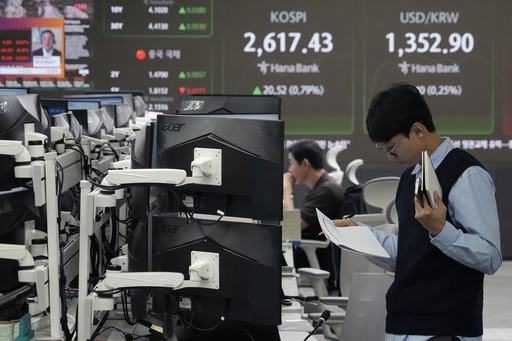
BANGKOK — Asian stock markets experienced a positive shift on Monday, particularly in China where indices surged more than 1%. This uptick followed comments from the finance minister, who indicated that further economic stimulus was necessary to address the slowing growth trend observed in recent months.
Meanwhile, futures in the U.S. remained relatively stable, and oil prices declined slightly.
The finance minister’s statements made over the weekend suggested that the government was exploring additional options to rejuvenate the economy, although specifics regarding a substantial new stimulus package were not provided. Investors and market analysts have been looking forward to a potential plan worth up to 2 trillion yuan, which translates to approximately $280 billion.
Typically, any indication of financial support boosts investor confidence, and state-controlled companies along with major financial institutions often step in to buy stocks, helping to stabilize market fluctuations, according to analysts.
Stephen Innes, from SPI Asset Management, remarked on the situation, noting, “The challenge lies in the specifics—or the conspicuous absence of them. Chinese policy announcements frequently lack substantial details.” He added, “By the middle of the week, it will be clearer if this market interest is sustainable, and by the end of the month, we’ll see if Beijing has concrete measures or if it’s just rhetoric.”
The Shanghai Composite index advanced by 1.7%, reaching a level of 3,271.06, while the Shenzhen index saw a 1.9% increase. Conversely, Hong Kong’s Hang Seng index decreased by 0.4%, landing at 21,164.93.
Recent data from China indicated a decline in consumer inflation for September along with decreased wholesale prices, highlighting persistent weakness in domestic demand. This condition has prompted the government to implement strategies aimed at boosting faltering housing sales and overall consumer spending.
Despite significant Chinese military drills around Taiwan occurring on Monday, market reactions appeared minimal. The Taiex index in Taiwan inched up by 0.4%.
Japan’s markets were suspended for a public holiday, while South Korea’s Kospi index climbed 1% to reach 2,622.43. Australia’s S&P/ASX 200 index recorded a 0.5% increase, finishing at 8,253.60.
This rally across Asia was supported by a strong performance on Wall Street the previous Friday, where U.S. stocks reached new highs propelled by impressive profits reported by major banking institutions.
The S&P 500 index rose by 0.6% to finish at 5,815.03, surpassing its prior record established earlier in the week, marking its fifth consecutive week of growth. The Dow Jones Industrial Average surged by 1%, setting a new high at 42,863.86. However, the Nasdaq composite trailed behind with only a 0.3% gain, primarily due to Tesla’s disappointing performance, closing at 18,342.94.
Wells Fargo’s stock soared by 5.6% following the reporting of quarterly profits that exceeded predictions, while JPMorgan Chase observed a 4.4% uptick in its share price after revealing a less severe profit drop than anticipated. This made them key contributors to the ascent of the S&P 500.
BlackRock also experienced gains, climbing 3.6% after posting stronger-than-expected profits for the latest quarter. The company ended September with record assets under management totaling $11.5 trillion.
Though bank performances bolstered market activity, Tesla’s shares plummeted 8.8% after the company’s much-anticipated robotaxi preview drew criticism for the lack of specific rollout plans. Following the introduction of this “Cybercab,” rival firm Uber Technologies surged by 10.8%, contributing to market optimism, while Lyft’s shares increased by 9.6%.
On the bond market, Treasury yields exhibited mixed results in light of the latest wholesale inflation data and U.S. consumer sentiment updates.
Producer prices rose by 1.8% in September compared to the previous year, a statistic better than earlier figures yet still below economists’ expectations.
Earlier on Monday, U.S. benchmark crude oil prices fell by 91 cents to $74.65 per barrel in electronic trading on the New York Mercantile Exchange. Brent crude, the global standard, also decreased, dropping 95 cents to $78.09 per barrel.
The U.S. dollar gained strength, rising to 149.30 Japanese yen from a previous 149.08. The euro experienced a slight decline, falling to $1.0926 from $1.0935.
